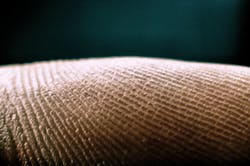Sensors Peer Through Smartphone Screens to Verify Fingerprints
A fingerprint sensor has been built that could enable tablets and smartphones with top-to-bottom screens, eliminating home buttons and making for stronger biometric security.
Synaptics, which supplies touch sensors to companies like Samsung and Lenovo, revealed the new optical sensor on Tuesday. The company said the sensor can scan fingerprints from underneath glass. That differs from capacitive sensors, like the circular button on Apple’s iPhone, which needs half an inch on the front of the device.
There is evidence that manufacturers are willing to experiment with alternatives to home buttons, as well as the passwords and pin numbers used to securely log into devices. Google, for instance, put the fingerprint sensor on the back of its flagship Pixel smartphone. Before it was recalled, Samsung’s Galaxy Note 7 could scan your iris to unlock the device.
The new sensor would not only expand smartphone screens but it could also bolster an already strong form of biometric identification. Synaptics’ optical sensors can distinguish between actual fingerprints and spoofs – counterfeits that are relatively simple to mold out of wood glue or plastic.
Its optical sensors can also confirm that fingerprints belongs to live people, as opposed to images that hackers have swiped out of a database. In the theft of almost 22 million federal employee records from the U.S. Office of Personnel Management in 2015, hackers looted over 5 million fingerprint images, which can circumvent traditional fingerprint security in smartphones.
Synaptics is facing competition from smaller peers. On Wednesday, the start-up Vkansee said that it had raised $10 million to develop its optical fingerprint sensors, which also hide beneath glass. Its high-resolution sensors can capture microscopic sweat pores, ridge textures, and other features in people's fingerprints. The company expects to start selling them in 2017.
Anthony Gioeli, vice president of marketing for Synaptics’ Biometric division, said that the new optical device is both waterproof and scratch-resistant. The company said that the fingerprint sensors would sample in the first quarter of 2017 and enter production in the second quarter.
About the Author
James Morra
Senior Editor
James Morra is the senior editor for Electronic Design, covering the semiconductor industry and new technology trends, with a focus on power electronics and power management. He also reports on the business behind electrical engineering, including the electronics supply chain. He joined Electronic Design in 2015 and is based in Chicago, Illinois.

